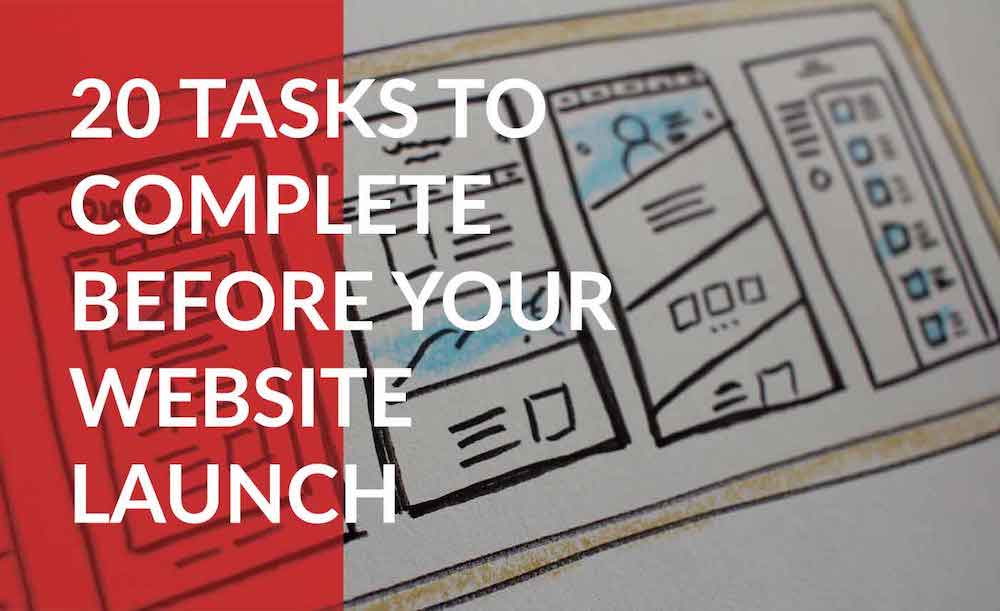20 Tasks to Perform Before Your Website Goes Live
Online marketing amateurs will tell you not having and promoting a website is bad for your business. But professionals will tell you one of the worst things you can do for your business is to have a website that’s lousy.
It can be overwhelming to keep tabs on everything necessary for your website. But it’s essential to ensure the back part of the website is operating and to know what people see when they use their browser.
You’ve lined up great images, simple navigation, and excellent content. Here’s a checklist to use to make sure you haven’t missed any necessary details so your online presence will shine.
20-Point Website Pre-Launch Checklist
1. Bring in Beta Testers
Whether you get them from a team of outside talent or your staff, have multiple people run through the functional aspects of your website to make sure everything works. Some of the most important elements include:
- Confirming images are optimized for quick loading.
- Testing that all fillable forms work as intended.
- Running through any logins and credentials.
- Confirming autoresponders respond automatically.
- Ensuring your shopping carts and payment processing work smoothly and quickly.
Have your testers also review each page to ensure it’s attractive, easy to navigate, and overall high-quality.
Your testers should be people who haven’t worked on the site. You want fresh eyes at this stage since the people who built it have levels of both familiarity and burnout that will make them terrible at this task.
2. Make Sure Calls to Action Are Clear
Look at each page on your site and ask yourself what consumers will do when they’re done reading it. It needs a clear call to action (CTA).
Some CTAs are apparent and intuitive. For example, a product page should have a button to purchase items. Others might lead to a contact form, educational content, or a product video.
Best results usually come from having two CTAs. Put one near the top of the page visible to users before they scroll. The other goes at the bottom, where they can see it when they’re done reading. These can be calls to the same action or opportunities to do different things.
Build Your Website Today
3. Check Grammar, Spelling, and Formatting
Do not have a typo on your front page, the wrong model number in the title of a product video, or a messy grammar mistake in your educational content. Those kinds of errors cost you authority, trust, and sales.
It’s not the most fun task in this process but review every page carefully for typos, spelling, and grammar. While you’re at it, review font size, use of white space, image placement, and similar factors that make your page easy and enjoyable to read.
Hire outside professionals for this if you can. If that’s not in the budget, assign two team members to each page. Neither will likely catch everything, but they should spot all the major issues between them.
4. Configure Permalinks
A permalink is a specific URL for a page on your site. It’s what the press includes in their writeup when referencing a page, what shows up when you link via social media, and what Google uses to index your content.
WordPress and most other site-building tools assign randomized, automatic names for these links. For example, a blog post about flower arranging for a florist’s site might initially be set as http://www.flowersforeverybody/blog/post129587. That’s not memorable or easy to remember.
It’s easy to manually change that to something memorable, like http://www.flowersforeverybody/blog/flowerarrangingfordummies. You will need to do this manually for every page.
5. Confirm It Works on Mobile
Recent research by Oberlo found that more than half of internet users shop on their mobile devices, and that number grows every year. Six out of 10 report that mobile functionality on a website impacts their opinion of a brand.
Use the tools in your web building suite to optimize every page for mobile, then have people run through it on every kind of phone and tablet they can find.
6. Create a Contact Page
You need a dedicated contact page for two reasons.
First, it creates a clear place for customers, leads, and potential partners to get in touch with you. Many of your calls to action will do the same, but some users want to find you directly. This lets them do that.
Second, contact pages add real and virtual credibility and trust. Not being easy and intuitive to reach makes people suspicious that you might hide from complaints and problems. This is so important that the presence of a contact page gives you a small but meaningful bump on many search engine algorithms.
7. Delete Unused Plugins
Websites built with a design suite typically have three kinds of plugins:
- Plugins you installed and still use
- Plugins you installed but no longer use
- Plugins that were installed automatically or accidentally that you never used
Only the first category of plugins belongs on your site. The other two eat up resources, slow down browsing, and contribute nothing in exchange.
Perform a plugin audit before going live. Uninstall and delete any plugin you don’t use.
8. Do an Accessibility Check
Making sure everybody, regardless of disability, can use your website isn’t just good karma. Increasingly, countries and smaller jurisdictions worldwide are mandating this by law. So, do an accessibility audit before your site goes live.
This is a complex task to perform a la carte, but fortunately, tools like WAVE (Web Accessibility Evaluation Tool) can check your site for issues and identify changes you need.
If you’re reading this post early in the process, consider choosing a theme for your site that’s built from the ground up for accessibility. It will save you time later.
9. Double-Check the Time Zone
This is small, easy, and important. Go into the time zone settings for your design suite and confirm the best choice for your company. This is usually the time zone where you’re located, but it might instead be the one where most of your customers live.
Because updates and automated maintenance are set according to the identified time zone, having this off-kilter can create problems at surprisingly inconvenient times.
10. Format Your Images
Images are vital for websites, resulting in significantly better engagement than text alone. But they can cause problems if you don’t set them up correctly. For every image on your site:
- Confirm its location works with other design elements across all platforms
- Enter ALT text for SEO and accessibility
- Make sure captions are compelling, error-free, and spaced well on the page
- Make sure the resolution is good enough to still look great on large monitors
Like your website overall, the only thing worse than no images is terrible images. Time spent on this step pays dividends over the lifetime of your site.
11. Install an SEO Plugin
Unless you have an in-house SEO expert working with every piece of online content, you need an SEO plugin. These consistently updated web tools scan your work for keyword usage, titling, meta description, and similar factors to make it competitive on search engines.
Yoast is the most-used SEO plugin and gets good reviews, but you have dozens of other options to choose from.
12. Install Security
Because your website is public-facing, it’s vulnerable to hacking, spam, and other exploitations. At best, these are annoying to your customers and time-consuming to clean up. At worst, they can mean a data breach or ransomware threats to your entire operation.
This is a complex topic well beyond the scope of a line item in a list. Login protection, anti-spam measures, secure SSL, and staff training are just four of the most critical factors you will need to see about this. If you don’t have an expert on staff, it’s worth hiring outside help for this vital protection.
Not doing this is like never installing locks on your front door.
13. Make a 404 Page
If you have a broken link or a visitor mistypes a permalink, they’ll get a 404 message, and one of two things will happen:
- They’ll see the default 404 screen for their browser.
- They’ll go to a custom 404 page with your branding.
The second is always more memorable and enjoyable than the first. Set up something on-brand, even a fun message letting the consumer know how to remedy the problem.
While you’re at it, set up email alerts to let your team know when people encounter a 404 error. That way, you can fix problems as soon as they appear.
Let us help you design your site.
14. Perfect the robots.txt File
This small but vital file helps search engines work through your content more quickly and efficiently. Setting one up is another job for an expert, but it’s worth the small investment.
15. Review It On Different Browsers
Different browsers interpret certain lines of code differently, so a page that’s beautiful on Chrome might work poorly on Edge. Just like you checked the site on mobile devices, use a desktop and a laptop to navigate through each page on the major browsers:
- Google Chrome
- Apple Safari
- Firefox
- Microsoft Edge
There are dozens of other off-brand browsers, but the market share on those is small enough you don’t need to worry about them unless your customer base is passionate about one.
16. Run Through the Navigation
Somebody needs to go through every page on your site, list every link on each page, and confirm all the links go where they’re supposed to go. The best virtual customer journey ever built does little good if a typo or copy/paste error derails the process halfway through.
It might be tempting to fold this step in with other page audits mentioned earlier in this article. Resist that temptation. Do this as its own dedicated task to keep the focus where it needs to be.
Consider making this a late step in your process.
17. Streamline Social Media
Websites are vital for business. Social media is a robust business tool. When you combine the two efficiently, they add up to much more than the sum of their parts.
Check your social icons to make sure they work correctly and link to the correct pages. Test your social sharing widgets and plugins to confirm they share the way you want them to share. Test drive several pages through the sharing process and make notes of any place problems pop up.
Social media buttons and functionality may take up only a fraction of your page’s real estate, but they represent a massive opportunity for free engagement and promotion. Give them the attention they deserve.
18. Triple-Check Your Backup
Before you hit the launch button, have a backup solution stored away from your main version. Test it to confirm it functions, and leave it alone.
Many things can go wrong with a site after launch, so the ability to restore to a stable and functional version can save time, resources, and stress. Make creating, protecting, and accessing this emergency tool a priority.
19. Update Your URLs
Priorities, structure, and preferences can change between the beginning of a web design product and launch day. Sometimes your team learns something during the design stage and makes changes in real-time. This means the URLs you assigned early in the process might not match the parameters you settled on by the end.
Go through your list of pages and check them one by one. Update those that need updating. Remember to update related links to match.
20. Ask Your Lawyers
Once you go live, you’ll be on the hook for legal liabilities. That’s why you’ll want to run everything by your lawyers.
Every business and industry has its own set of legal needs, but most companies should check for the following things:
- Licensing and copyright for images, fonts, audio, video, and similar content you didn’t create in-house.
- Language and instantiation of terms of service or end-user license agreement (EULA).
- Terms and conditions for any purchases made through the site.
- A privacy policy announcing how you use any data your site collects.
- Cookie warnings as required in your jurisdiction.
Like any other legal situation, these details seem small but can lead to big problems if not handled early and effectively.
Final Thought
Keep in mind that, even once you’ve run through this checklist, your job is far from done. The best, most profitable websites are eternal works in progress. You should tweak, adjust to feedback, add content, cycle promotions, update staff pages, and a seemingly endless array of other tasks to keep your site attractive, up to date, and attention-getting.
It sounds daunting, but it’s worth it. As long as you start strong, your website can be the advantage you leverage to beat your competition and thrive.
Lilly Johnstown is a web designer in Montana and has crafted many strategies to help small businesses bolster their content marketing strategies on their websites.



